|
|
Post by Karl Welteke on Mar 17, 2008 14:04:20 GMT 8
On the 15th of March 2008 the Corregidor Foundation Inc ‘On Site Manager’, Mr. Ronilo Benadero (Ron) took me to the Kindley Airfield on Corregidor Island to help identify a defense emplacement. These photos will help you identify that emplacement and show the reason for his request. Note: These pictures have been posted here on the 20th Aug. 2013 and the new descriptions do not fit the original intend to make these images available to identify the location. Before this date here was only a URL/link where these image were before. 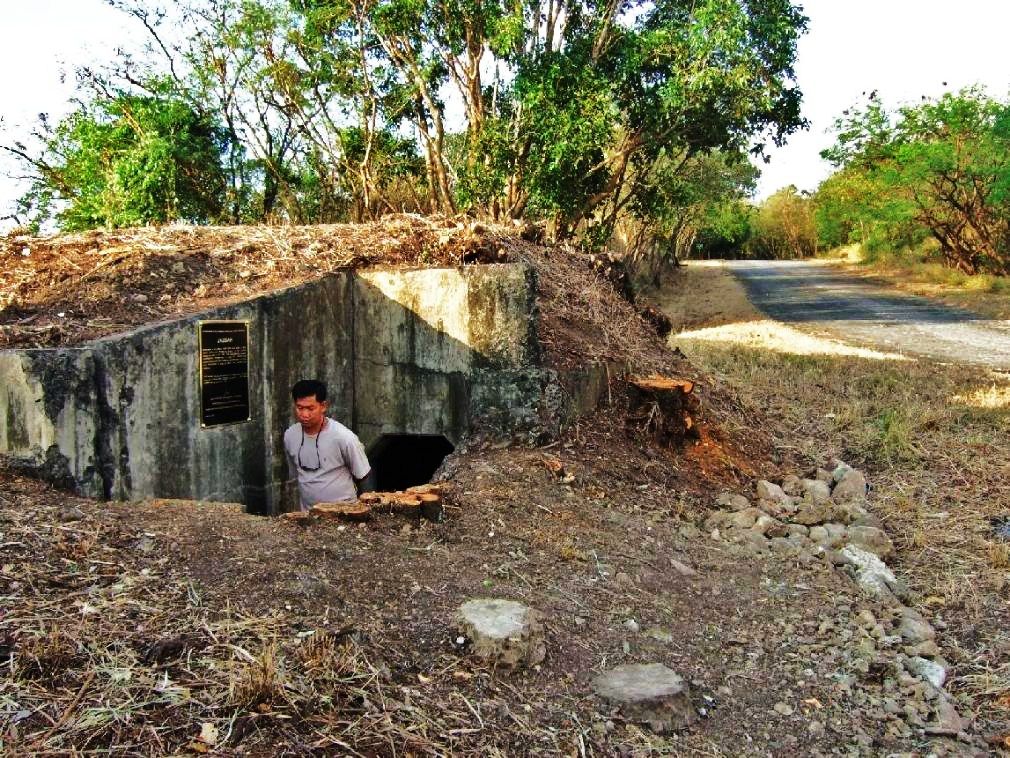 Z374-A man is coming out of the magazine of WW-I defense position at entrance of Kindley Field, pic is dated 2008-03-15. Corregidor Foundation Inc. (CFI) just cleaned it up to have a formal Unveiling Ceremony on the 18th March 2008. 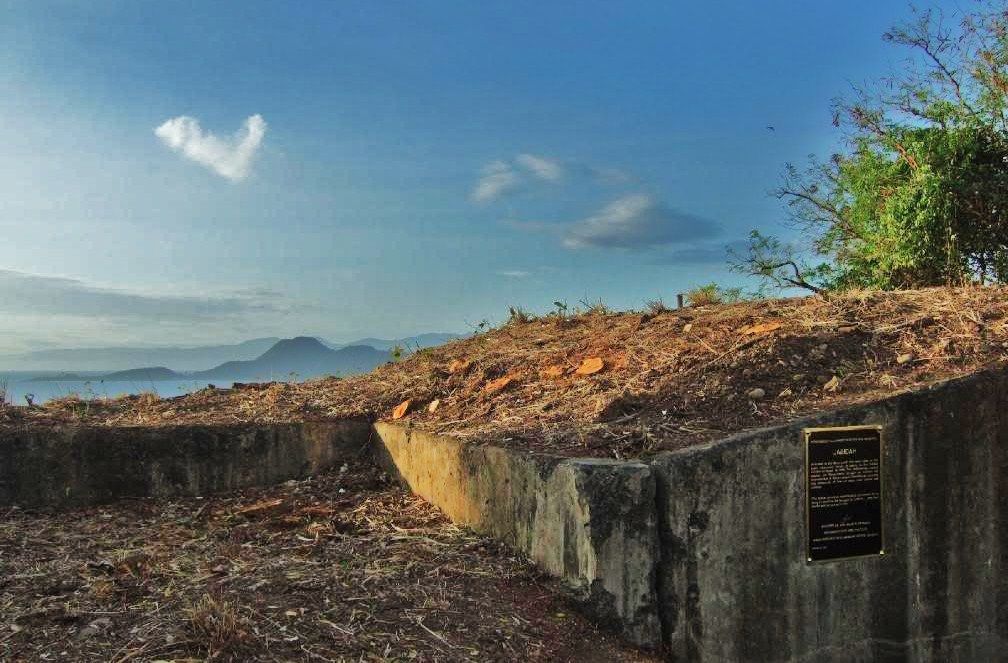 Z375-I took this shot this way to show Caballo Island, ex Fort Hughes to help identifying the location of this WWI defense position, and now I know it is I-M-I. 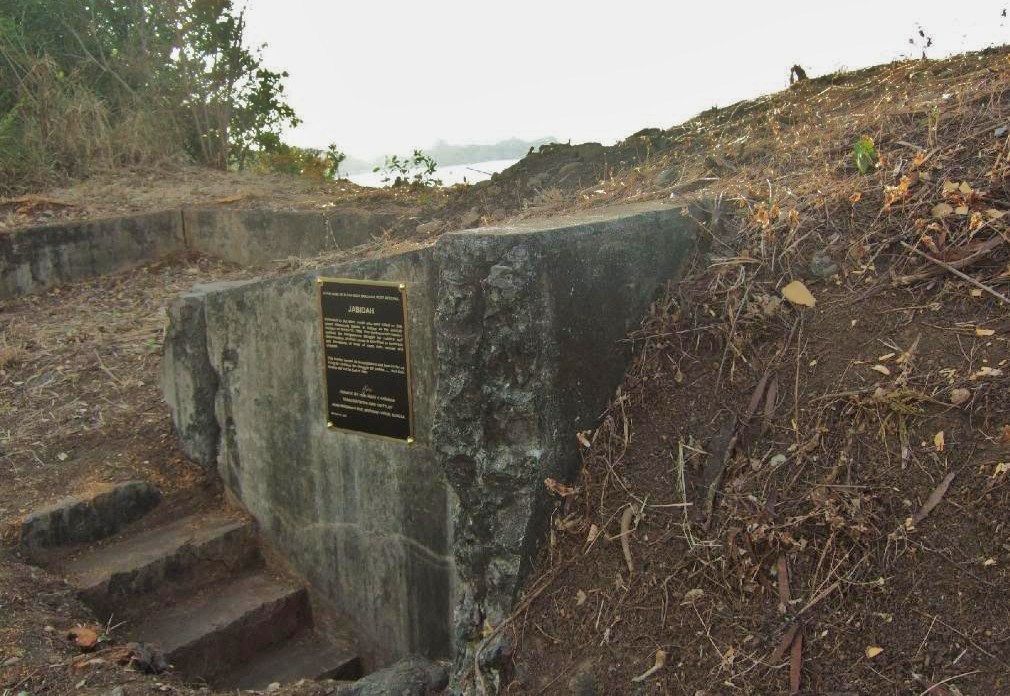 Z376-The new Jabidah Plaque is posted at the steps to the magazine of this WW-I defense position at entrance of Kindley Field, pic is dated 2008-03-15. 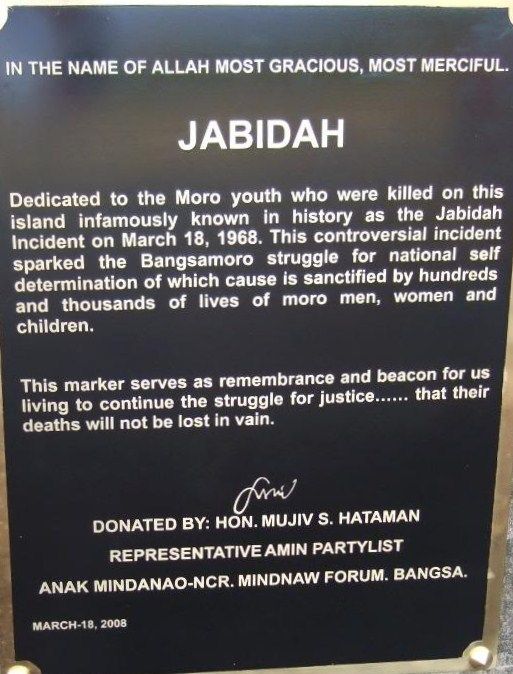 Z377-This 15th March 2008 picture of this plaque, scheduled to be unveiled in three days time, on the 18th March 2008 at the 30th Anniversary of the Jabidah Massacre. The plaque says what it is all about. The Anakmindanao Party List Philippine Congressional Representative and other officials with CFI will conduct this ceremony as a first step to develop this place as a memorial. 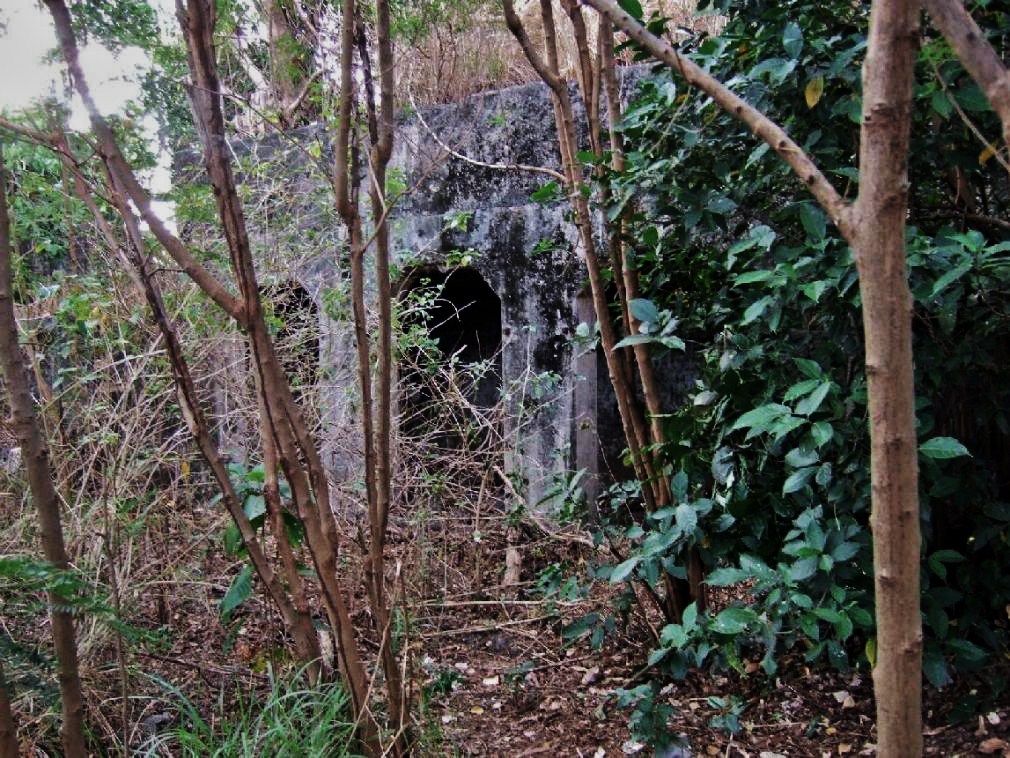 Z378-Now I know this is the WWI defense position I-F-I and now we also know it is an important part of the new Mindanao Garden of Peace to remember the Jabidah Massacre. But in March 2008 I made this below description to this picture: Only about 30 meters further east, along the south cliff top is this emplacement. I'm presenting this image to show that this emplacement was not used for the new JABIDAH plaque. I knew about this defense position but not the one with the new Jabidah Plaque. I never had noticed the emplacement with the new plaque before; I knew about this one in this pic. So I told Ron I send out an email to my friends to inquire. They may respond in this forum or I will post their answers. But what is really IMPORTAND is that plaque. I just faintly remembered something about that infamous event. Ron told me that there would be an official dedication of this plaque on the 18th of Mar.2008 because this was an anniversary of this event. On Corregidor is no Internet connection, so when I returned home yesterday, the 16th Mar. I googled and found a news story about people coming from Mindanao to attend the dedication of this new JABIDAH plaque. This group of people coming includes the survivor of this alleged massacre. Corregidor is full of surprises. I came across this surprise because some friends ask me to show them Corregidor and we were there for two nights and three days. Another surprise was, that the Rowhouse was completely booked full but we got some rooms at MacArthur Café. |
|
|
|
Post by batteryboy on Mar 17, 2008 17:50:32 GMT 8
Hi Karl, Based on the location you described and on the photos you sent, the place is called "I-M-1" meaning: I" - 1st Sector, "M" - Machinegune, "1", the 1st Machinegun emplacement in the sector. This was part of the early Land Defense Project of Corregidor as the island was divided into ten (10) land defense sectors. This single platform concrete emlacement with a magazine can be seen on the 1936 COE map of Corregidor.  Usually during those times, it was either armed with the old Benet Mercie 1909 Machinegun (similar to the Hotchkiss 1909 model) or even with the earlier Gatling Gun type. It can also accomodate the latter heavy machineguns such as the Colt M1917 Water-cooled browning. There is no record of the wartime use of the emplacement since the Japanese landed on the opposite side. It may have been used as a storage area for ammo and supplies supporting the troops in the tail side. Regards, Tony a.k.a = batteryboy |
|
|
|
Post by EXO on Mar 17, 2008 19:16:40 GMT 8
Gentlemen, We couldn’t do any better than what Tony (a.k.a. Batteryboy) has said, and the copy of his scan – but I’d like to add for the record this article which I researched and wrote a few years ago, and which I have seen referred to favorably in academic circles and historic articles. corregidor.org/heritage_battalion/jabidah.htmlThe intent of the article was to weave into the accepted tapestry of Corregidor's history an internet accessible “for the record announcement” that history’s last page on Corregidor didn’t end in 1945. I started researching the issue with a blank slate – I had no preconceptions - no idea what was the cause of the Jabidah incident, or even if the incident was real or rumor. Who was right, who was wrong, and what of it? I had no idea. There are many things which occur here in the Philippines which seem to disappear without trace. It's a trite saying that "It’s the victors who write the history." Well there's a corollary - "In some cases, the victors leave blank pages too." I am reminded that, speaking in the context of the trial (and execution) of General Yamashita, General Curtis LeMay himself admitted to Robert McNamara that "if we'd lost the war, we'd all have been prosecuted as war criminals." Governments have many powers, one of which is to take steps against the quest for the whole truth, because those within that government see such a quest by its opponents as a plot to promote instability. (It was in such circumstances that former president Estrada was hounded from office, after his lawyers prevented the opening of an envelope which was said to have contained "the truth". ) So effective have the spin doctors and syrup speakers become, that to dig for the truth can be considered a subversive act. My view, after I researched the issue ,was that the Bangsamoros had a genuine complaint against the Manila Government and the elites that were running it through Marcos. Malaysiaa certainly took things in Sabah very seriously, and it is said they financed the building of an army because of it. At the time there were allegations of a cover-up by Marcos and his cronies, those allegations published overseas by none other than prominent reporter, Benigno Aquino - who was assasinated upon his return to Manila. The policy involving claims to the right of self-government in Bangsamoros areas remains essentially unchanged and adversarial today, which is to say that the peace talks are still ongoing. There is a large army in Mindinao still today, and they are not planting daisies. The Bangsamoros have complaints, even today – though in many respects, so does every individual or group which suffers from the failure of a government to eliminate its own institutional bias or corruption, and that is no justification for war. (This comment applies to governments everywhere.) At the risk of straying off the track I also am reminded of the story from the American Civil War, in which a Northern soldier asked a Confederate Soldier why he kept on fighting against the Union when he didn't own any slaves. The destitute Southerner replied "Because you're down here." There still are problems which can only be redressed by robust honesty, and accordingly I consider this memorial one of those upon Corregidor which deserves our respect and support. EXO |
|
|
|
Post by EXO on Mar 20, 2008 0:03:11 GMT 8
That’s what it is – all baseless speculation. You pays your dime, you gets your theory…
We are what is called the CHATTERING CLASS. We aren’t in on any of the secrets, and the winds of speculation swirl around us like a sandstorm.
Not a single person who knows the Jabidah facts has told. I said before, Victors write the history, but sometimes the pages are left blank.
|
|
|
|
Post by Mike on Mar 20, 2008 8:11:20 GMT 8
The Philippine Daily Inquirer, published this article on 18 March, 2008
Lone survivor recalls Jabidah Massacre
By Jocelyn Uy
Philippine Daily Inquirer
CORREGIDOR ISLAND, Philippines -- The atrocity that happened here 40 years ago had long receded from Jibin Arula’s consciousness.
But when he set foot again on this island Tuesday to lead a caravan from Mindanao in commemorating the infamous "Jabidah Massacre," memories of how his fellow Muslim youth were killed by military officers came rushing back to him like it all happened just Tuesday.
Even the rough waves that punctuated the 30-minute boat ride from the shores of Mariveles, Bataan, to the island reminded him so much of the currents he fought against for four hours to swim to safety, Arula said.
Out of the roughly 60 Muslim youth summarily executed, only Arula, then 27, survived to tell the story -- which played a pivotal role in the war in Mindanao, giving birth to the Moro National Liberation Front (MNLF).
Arula recalled he and the other recruits were brought to the island on January 3, 1968 for training on guerrilla tactics in preparation for "Operation Merdeka," then a top-secret plan of the Marcos administration to invade the east Malaysian state of Sabah which the Philippine claimed as part of its territory.
Their training officers fired at them before dawn on March 18, 1968 after an attempt by the trainees to air their grievances against the officers to Malacañang. Arula, who was hit by a bullet on the left knee, swam for his life across Manila Bay.
Looking back, the 67-year-old survivor admitted that his revelations, which triggered a full-blown Senate inquiry but led to nothing, ruined not only his future but also his children's.
His four children by his first wife did not finish their schooling while his three children by his second wife managed to get some although this was insufficient, he said.
At one point, he became consultant to MNLF leader Nur Misuari, which allowed him to take home P7,000 monthly -- enough to put food on the table and sustain some of the needs of his children in school.
But the rest of his life, he said, was spent in fear and in hiding -- mostly in Antique. For two years now, he has been living with his youngest child in Binondo, Manila for support.
"So now, all I am asking is for President Gloria Macapagal-Arroyo to help me and Mindanao as well. Though it wasn't her fault, it is still the same Philippine government we are talking about," he told the Philippine Daily Inquirer in an interview.
If the Mindanao Peace Caucus (MPC), an organization that spearheaded the five-day peace caravan, had not sought him out, he would have not minded the occasion at all, he admitted.
About 60 members of the MPC and other groups advocating peace came to Corregidor on Tuesday to end the five-day caravan that began in Mindanao, with calls for the government to immediately sign the peace agreement with the Moro Islamic Liberation Front.
"We are already in the crucial stage of the negotiations, with 90 percent of the points concerning the ancestral domain finished. So we are calling on the government to exercise its political will to sign the accord," said Mary Ann Arnado, MPC secretary general.
She added that the government should not wait for the centennial of the Jabidah Massacre to provide solution to the conflicts in Mindanao.
The group's peace journey culminated with the unveiling of a marker remembering the massacre, with Arula on hand.
The emblem, donated by Anak Mindanao Representative Mujiv Hataman, was fixed on a partition of the World War II ammunition bank overlooking the grassy Kindley airfield, the site of the massacre.
A portion of the marker read: "...this controversial incident sparked the Bangsamoro struggle for national self-determination which cause is sanctified by hundreds and thousands of lives of Moro men, women and children.... This marker serves as a remembrance and a beacon for us living to continue the struggle for justice that their deaths would not be lost in vain."
Upon reaching the airfield, Arula immediately climbed a small hill beside the old storage bank, which offered a view of Manila Bay and Cavite at a distance.
There, he gave the group snippets of his ordeal that began with small grievances aired by his fellow Muslim recruits. At first he was hesitant, saying that it was his first time in years to talk to a large crowd about the tragedy.
But he recounted the whole event in about 40 minutes, not sparing any detail and conversation he heard during the fusillade.
He said among the complaints which they articulated in a letter to Malacañang were the kind of food they ate (mostly dried fish) and the women that their officers brought to the camp.
However, the letter most likely was intercepted by the military officers, which led to the tragedy, he recalled.
Going back for the first time in 40 years to the site where he lost his friends and relatives, Arula remained stoic.
His face, now wrinkled by time, was devoid of any emotion as he identified the places and buildings on the island that were memorable to him -- some of which had been given a facelift.
But he did not regret accompanying the group to the site. Arula said he was happy because he was able to share a piece of history in Mindanao's struggle, which the younger generation was not familiar with.
"I am glad that somehow I was able to tell the history of the Bangsamoro. What I am asking for is help from the government and for the MNLF and MILF and the Christians and Muslims to unite," he told the crowd.
"We may pray differently, but we have the same God. We are brothers and sisters," he said.
Though he has remained silent for years and stopped working for Misuari in 2000, he said he still supported the call of the Moro rebels for a separate state.
For a lasting peace in Mindanao, he said.
|
|
|
|
Post by AJM on Mar 20, 2008 8:16:16 GMT 8
After reading this story I remembered seeing the year '68' on some graffiti when I was on Corregidor last month. I took a few photos of it and have attached one here. Note the date of January 3rd, 1968 and Sulu in Mindanao. Was this one of the unlucky souls?  |
|
|
|
Post by Corregidoc on Mar 20, 2008 8:17:55 GMT 8
Where in the hsopital is the graffiti? I don't remember seeing any?
|
|
|
|
Post by Karl on Mar 20, 2008 8:22:38 GMT 8
There is a slew of Moro names on some walls and I don't remember exactly where. And I never made it a project to take pictures of them all. Attached is a pic which I only marked as 2nd floor, west end of hospital. Funny this one also has a date of 3rd Jan 1968.  And I wouldn't call it the Graffiti either; I would say they done a clean job of writing the names on the wall. |
|
|
|
Post by EXO on Mar 20, 2008 9:08:18 GMT 8
Karl, you are right - we see graffiti tags around all over the place - a bit like dogs pissing on a wall to record that "Kilroy was here!" - But these Hospital ones aren't in that style at all. I agree with CFI when they blot out the graffiti elsewhere, but something tells me that these should be should be allowed to fade naturally. I find these in my archives, circa 2003. That date is a recurring theme. The names seem to be in two "styles" - Moro and Christian, separately. Two separate stories? It's a bit of Corregidor History that I will leave for someone else to investigate. I am popping smoke. |
|
|
|
Post by Karl Welteke on Mar 20, 2008 21:17:59 GMT 8
My friend from the Coastal Defense Study group (CDSG) sent me this information: The battery was one of the 41 machine gun positions of the Ft. Mills land defense projects. These were built in two waves, eighteen in 1914 and twenty-three more in 1917. I-M-1 was one of the earlier units completed for transfer to troops by November 25, 1914. It consisted of a small ammunition magazine and platform for a Benet-Mercie machine gun (probably later replaced with a Browning). Of course the guns were normally kept in storage and not actually "mounted" except in time of use. Apparently the land defense system was abandoned as such in the late 1920s, though a number of the positions were modified for later guns and used during the 1942 campaign as beach defense positions. He also sent this 1917 table of the Land Defense Positions:  |
|




















